Site menu:
It's like entering a different world when you cross the foot bridge at Gronant. You leave the hustle and bustle of the massive caravan parks and busy main line railway and main road, and enter the peace and quiet of sand dunes, dune slacks, reed beds and beach, full of birds and wild flowers. Gronant is good for birds at any time of year but, for me, it's at its best mid summer when the Little Terns are busy in their colony, the Sandwich Terns are plentiful along the beach with their raucous cries and out to sea are Gannets, Manx Shearwaters and Common Scoter.
How to Get There
By road take the A548 which runs from the A550 (north of Queensferry), through Flint, Greenfield and Mostyn, past the roundabout by the Talacre/Point of Ayr turn off. After this roundabout the road bears to the left, enters a dual carriageway and after about a mile you will see a junction and sign post, right, to Lower Gronant and Presthaven. If coming from Prestatyn you will reach this same junction after about one mile. Follow Shore Road and go over the railway bridge, at the end of the road is the entrance to Preshaven Caravan Park. If you ask nicely they might let you park in the caravan park, otherwise there is a car park on the inland side of the railway bridge.
By Bus and Train: the nearest railway station is at Prestatyn, this is on the main line between Chester and Holyhead. From Prestatyn there is a bus service to Gronant, the No. 11, 11A and 11X, these buses run between Rhyl and Chester. Alternatively there is a pleasant walk from Prestatyn to Gronant along the shore of just over one mile.
Where to Go
Go through the gate opposite the entrance to the caravan park and you will see the footbridge over the river to your left. The main path to the beach, viewing platform and Little Tern colony is marked in green on the map below.
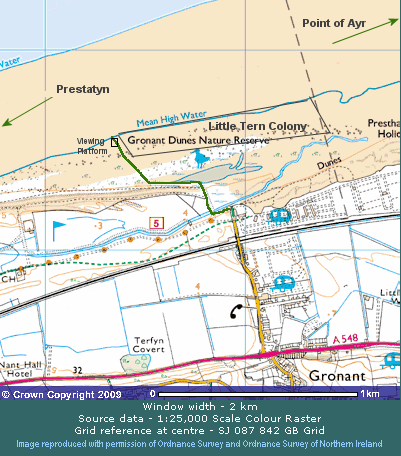
Scrub and Grassland.
Before crossing the footbridge it is worth exploring a quite extensive area of scrub and rough grass to the left of the tarmaced track. In spring there will be a good selection of warblers including Garden, Grasshopper, Whitethroat, Lesser Whitethroat and Willow, and there is usually a pair of Stonechats in the area. Migrating Spotted Flycatchers sometimes pass through.
The River, Reedbeds and Lagoon.
From the footbridge you should see a selection of waterfowl on the river, in winter these should include Little Grebe, Teal and Wigeon as well as the usual Mallard and Mute Swan. Kingfishers can sometimes be seen from the bridge, the river also attracts good numbers of hirundines in the summer months. The nearby reedbed will have Reed Bunting, Reed Warblers, Sedge Warblers and rarely seen Water Rails breeding. There is a much more extensive reedbed beyond the lagoon and beside the river as it winds its way towards the sand - well worth a look.
During a dry summer the lagoon can dry out but there is always some water at the eastern end. Little Terns can sometimes be seen feeding here. The lagoon attracts Little Egrets, Grey Herons and Mallard, and during spring and autumn migration Common and Green Sandpipers are a welcome sight. In June 2007 a Great White Egret was seen here.
If you walk eastwards past the Lagoon and follow the river you eventually get to the river outfall where the water disappears into wet sand. This is particularly attractive to a large number of gulls and in summer there is usually a large Sandwich Tern roost here. During migration look out for Common and Green Sandpipers. Small flocks of waders and Shelduck also use this area for feeding and roosting, there may be Curlew Sandpipers here in late August and September.
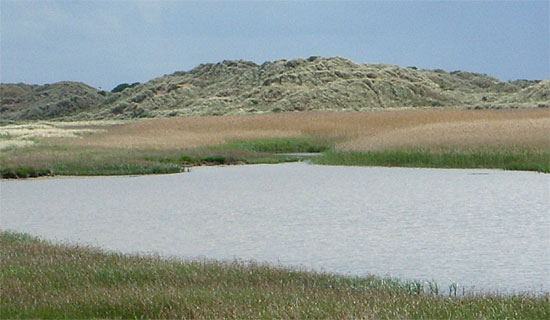
these carry on all the way to the Point of Ayr, © Richard Smith.
The Sand Dunes and Dune Slacks.
Full of singing Skylarks and Meadow Pipits in spring. As summer progresses the wildflowers in these dunes are fantastic with, among many other plants, yellow Birds Foot Trefoil and purple Orchids giving way to the lovely Sea Holly. By the end of June many birds will already have finished breeding and there are always large flocks of Linnets and Starlings flying around with many juveniles among them. The warm dunes attract much insect life and this in turn attracts large numbers of Swifts and hirundines, some days there is a constant procession of these birds occasionally followed by a Hobby or two.
The sand dunes at Gronant are relatively low lying, presumably because they are exposed to winter gales, but if you look inland past the caravan park you will see much larger sand dunes. These stretch all the way to the Point of Ayr and are part of the area called The Warren. At one time these stretched a total of four miles, all the way to the River Clwyd at Rhyl.
The low lying area between sand dunes is called a dune slack, and as they are close to the water table they attract there own special flora which will be of special interest to those botanists among you. At Gronant much of this dune slack area will be flooded in winter, either after heavy rainfall or during a high spring tide - this in turn attract Snipe, Jack Snipe and various wildfowl. In winter the whole sand dune area can attract Short-eared Owls and various raptors including Peregrines.
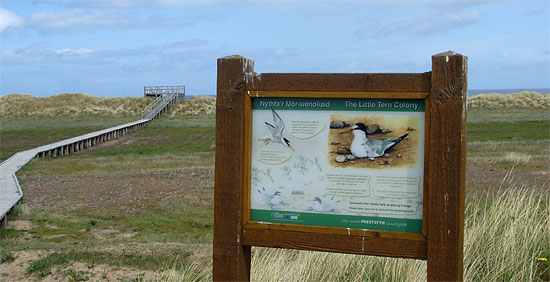
crossing a Dune Slack which is often flooded after heavy rain or a very high tide. © Richard Smith.
The Shingle Ridge and Beach.
The outermost 'sand dune' is in fact mostly a shingle ridge largely devoid of vegetation. This is where the Little Terns breed and these are present from mid-May to early August. Read more about the Little Terns in the May 2008 and May 2009 newsletters.
Please do not enter the roped off area which protects the Little Tern colony from disturbance, unless with permission of the wardens on duty. On the seaward side of the colony the rope is close to where the terns are nesting, we would prefer to have more of a distance between the rope and terns but when the tide comes in this would be swept away. So if you walk down the seaward side of the colony please keep a good distance away from the terns to avoid stressing them. We would also ask people NOT to walk along the beach in front of the colony when the tide is in as there are always large numbers of birds on the sand at this time and it would be preferably both for the birds and watching birders if these were not disturbed.
The shingle ridge also holds breeding Ringed Plover and Oystercatchers, the latter being particularly good at chasing the crows away!
In winter this is a good place to find Snow Buntings and Twite, Shore Larks have been recorded here in the past. Autumn and Winter is the best time to see the waders on the beach with flocks of Oystercatchers, Grey Plover, Ringed Plover, Dunlin and Sanderling.
The beach is home to large groups of gulls and roosting cormorants at any state of the tide and any time of year. Look out for scarce gulls among the large flocks, such as Mediterranean and Yellow-legged Gulls - and perhaps something much rarer. By early July large numbers of Sandwich Terns will be on the beach, several hundred, and as July progresses all three species of terns - Common, Little and Sandwich - will be seen in good numbers, a great sight as the tide comes in.
A visit during the spring migration can prove very rewarding, sometimes the beach is covered in a hundred or more White Wagtails. Wheatears, Tree Pipits and Redstarts will also be passing through.
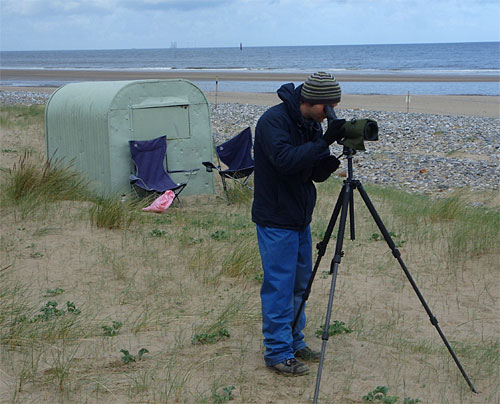
with the beach and open sea beyond, © Richard Smith.
Seawatching.
Just to the west of where the terns nest is a viewing platform giving good views of the colony, the beach and the sea. Through the summer Gannets will be in constant view out to sea and a fresh west wind will bring in both Manx Shearwaters and the much more difficult to see Storm Petrels. Arctic Skuas are relatively common but Great, Long-tailed and Pomarine Skuas may possible be seen particularly during strong winds from August to October. A prolonged north-west gale during September and October should result in a steady passage of Leach's Petrel with many close to the beach. Common Scoter are present off here at any time of year, in summer flocks of 30 to 50 flying in classic arrow-head formation are common, but in winter and early spring thousands can sometimes be seen carpeting the water. Other sea birds often observed are Kittiwakes, Fulmars, Guillemots, various divers and grebes, and Red-breasted Mergansers.
During the summer breeding season and return passage the sea is full of terns, as well as the commoner species already mentioned both Black Terns and White-winged Black Terns are occasionally recorded.
Mammals are rare but there are usually some Grey Seals hunting for fish just off the beach, Dolphins and Porpoises are also occasionally spotted.
May Bird News
Strong south-west winds, particularly in the second week, blew in very good numbers of seabirds; highlights were 630 Gannets and 110 Manx Shearwater off Hilbre, 155 Manx Shearwater and at least 200 Kittiwake off Hoylake, 12 Arctic Tern and 2 Arctic Skua off New Brighton - all on the 8th. The following day 5 Eiders, 350 Sandwich Terns and 150 Common Terns were off Hilbre and 76 Great Crested Grebes were on a calm sea at Hoylake on the 10th. A more unusual sight of a drake Eider was when one was observed landing in a field by Decca Pools on the 3rd. Single Black Terns were at Wallasey on the 10th and at Inner Marsh Farm on the 14th. A Pomarine Skua was off Point of Ayr on the 6th.
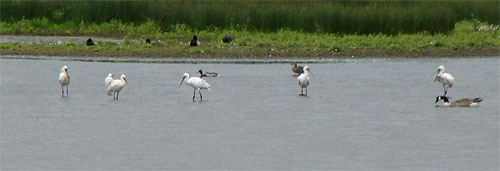
It was a good month for Spoonbills with at least two or three around all month then five turned up at Inner Marsh Farm on the 25th and six on Parkgate Marsh on the 30th. As usual there have been plenty of Little Egrets around but 25 feeding on the mud on the drained West Kirby Marine Lake was surely the largest number ever seen in that area. Up to nine Whimbrel have also been feeding there, 24 at Hilbre early in the month was the highest count. Other waders include at least 750 Black-tailed Godwits at Inner Marsh Farm with about 650 also at Connah's Quay, a Curlew Sandpiper was observed briefly at Leasowe on the 8th and there have been small flocks of Sanderling, Dunlin and Ringed Plover passing through all month. Max count of Spotted Redshanks was four at Inner Marsh Farm on the 4th, nine Avocet were there on the 6th. Four Common Sandpiper was a good spring count at Gilroy Nature Park, West Kirby, on the 15th.
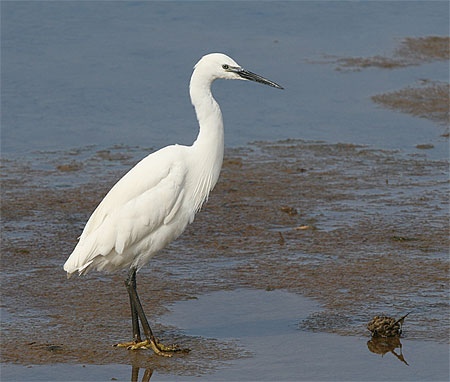
A few Marsh Harriers passed through with a female reported several times at Inner Marsh Farm towards the end of the month. Only one Osprey was observed, one on the 1st at West Kirby - being mobbed by four Ravens. At least two Short-eared Owls were still present on Burton Marsh through the month.
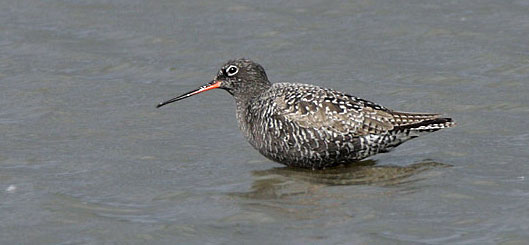
A single Dark-bellied Brent Goose was reported from Gilroy Nature Park on the 2nd and a Pale-bellied Brent was on Hilbre for several days towards the end of the month - both very late records.
Fresh winds and some clear skies meant there wasn't much in the way of visible migration but seven Spotted Flycatchers at Red Rocks on the 14th was a good number.
Richard Smith.
What to expect in June
Out on the estuary June is the quietest month of the year, but there is still plenty going on. At the beginning of the month a few Sanderling, Ringed Plover, Dunlin and Knot may still be seen on their way to the high Arctic to breed - they will be in a hurry so won't hang around for long. By the end of the month we start to see the first returning birds, the most noticeable being Curlew with typically a thousand birds back at Heswall. Other early returning waders could include Common Sandpiper, Green Sandpiper, Wood Sandpiper and Greenshank. There are also some non-breeding waders which over summer here including several hundred Black-tailed godwits at Inner Marsh Farm, sometimes we also get good numbers of Knot here as well. Occasionally we get an adult wader in full breeding plumage, presumably failed breeders, such as Curlew Sandpiper and Bar-tailed Godwit looking resplendent in red feathers.
Shelduck have a post-breeding peak on the estuary prior to moulting with typically three or four thousand off Heswall, Parkgate and Burton through the month.
Strong west winds will make for good seawatching with Arctic Skuas, Manx Shearwaters and plenty of Gannets, and perhaps a few Storm Petrels. Terns will be busy in their breeding colonies with Common at Shotton and Little at Gronant, and by the end of the month numbers of Sandwich Terns start to increase as they gather here after breeding.
Forthcoming Events
June Highest Spring Tides (Liverpool)
Also see
Tides page.
24th June, 13.13hrs (BST), 9.4m.
25th June, 14.04hrs (BST), 9.4m.
Forthcoming Events
Organised by the
Wirral Ranger Service ,
Flintshire Countryside Service and/or the RSPB:
All these events and walks have bird interest, even those not advertised
specifically for birdwatching. No need to book for these events unless
specified - please check below.
Sunday 7th June 10.30am – 12.30pm, Up Hill and Down Dale.
Join the Ranger for a guided walk over Heswall Dales and along the Wirral
Way through the Dungeons. Meet Oldfield Road off Quarry Road West,
Heswall. Booking essential. Tel: 0151 648 4371.
9th June - Wildlife Photography for beginners at
Inner Marsh Farm (RSPB event).
£15 for the full day session which includes expert tuition and workshops
by Ron Thomas ARPS
Booking Essential - please ring 0151 3367681.
Thursday 11th June, Sunset Walk to Hilbre.
Cross the sands to discover the Island’s wildlife and history. A 4 mile
walk of 4 hours, ideal for first time visitors. Please bring warm
waterproof clothing and a snack. Wellies recommended. All children under 8
must be accompanied. Sorry no dogs. There is a £1 charge per person for
this event. Booking essential. Tel: 0151 648 4371.
13th and 14th June - Orchid Spectacular at
Inner Marsh Farm (RSPB event).
£3.50 members, £4.50 non-members - Fantastic displays of the orchids at
IMF.
Booking Essential - please ring 0151 3367681.
28th June - Dragons and Damsels at
Inner Marsh Farm (RSPB event).
£3.50 members, £4.50 non-members - Looking for the scarce red-eyed
damselfly and many more.
Booking Essential - please ring 0151 3367681.
|
 |
The blank (UK) Birding Webring is a collection of quality birding web sites that are based in the United Kingdom. Visit the webring homepage for more information, or A complete list of all the sites in the webring is available by clicking here. previous site in ring : random site in ring : next site in ring |
